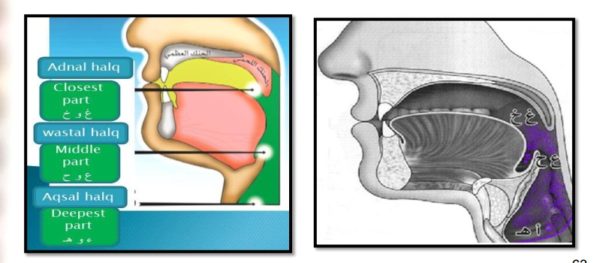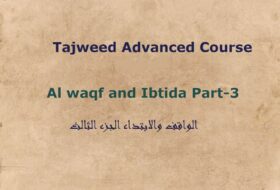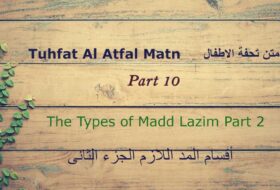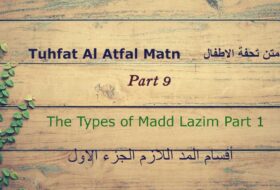Tajweed Course for beginner Part-4
Al-ITH-HAAR(Al-HALIQE) الإظهار الحلقى
– Izhaar means: Clear
–Definition In Tajweed: Pronouncing every letter from its articulation point without a ghunnah on the clear letter.
-There are six letters which when preceded by ‘nun sakin’ or ‘tanween’, they are to be pronounced with ‘idh-haar’.
– Izhaar Letters: the throat letters : { ءََََ هـََََ عََََ حََََ غََََ خ }

– The sound of (ن ) is pronounced clearly (without a nasal sound or ghunna).
–Note: All these six letters have the sound from the throat and are sometimes referred as huruf-al-halaqiyya (throat letters).
-If a Noon Saakin or a Tanween is followed by any of the six throat letters, The Noon Saakin or the Tanween is pronounced clearly from its respective origination without Ghunnah.
Practice reciting the following words

Note:- If the Tanween is followed by Hamzatul wassl( همزة الوصل ) , the reader is supposed to pronounce the noon in the Tanween like Noon with Kasrah.
Example: يَوْمَئِذٍ الْمُسْتَقَرُّ
Tuhfat Al Atfal Matn (Noon Sakinah&theTanween) :
فَـالأَوّلُ الإِظْـــهَارُ قَبْلَ أَحْـــرُفِ للحَلْقِ سـتَّ رُتَّبَتْ فَلْتَعْــرِفِ
VOCABULARY:
فَـالأَوّلُ – The first
الإِظْـــهَارُ – Al-ITH-HAAR
قَبْلَ – before
أَحْـــرُفِ – letters. The plural of حرف letter
للحَلْقِ – for the throat
سـتَّ – six. It can be read as ست There is not much difference in the meaning.
رُتَّبَتْ – arranged (in order or sequence). It refers to ست ِ Before it.
فَلْتَعْــرِفِ – so know them (these six letters of the throat). This word can also be read as فلتعرفى .Its meaning would then be: let them be known .
TRANSLATION:
So, the first (of the four rules) is Al-ITH-HAAR , before the letters of the throat which are six, arranged in order (of their Makharij from the lower throat upwards), so know them.
COMMENTARY:
The first of the four rules is iṭḥ-hār. It literally means ‚clear‛. If the Noon Saakina appears before any of the six letters of the throat, then ITH-HAAR will take place; it will be read clearly without any extra nasal pull.
In some prints قبل احرف with replaced withقبل احرف The first is more common and is relied on In the following line, the letters of the throat are mentioned in their order of pronunciation from the lower throat upwards.
هَمْــزٌ فَهـَاءٌ ثُمَّ عَيْنٌ حَـــــاءُ مُهْمَلَتَــانِ ثُـمَّ غَيْنٌ خَــاءُ
VOCABULARY:
ثُـمَّ – then
مُهْمَلَتَــانِ – referring to the ʿAyh and the ḥāʾ.The word مهملة means dotless or without dots (diacritical marks).
TRANSLATION:
The Hamzah and the haʾ, then the Ayn and the ḥa which lack dots and then the ghayn and the kha.
COMMENTARY:
In this line, the six letters of the throat are mentioned. Thus if a Noon Sakinah or Tanwin appears before any of these letters, iṭḥ-har will take place .
Put any question in comment














